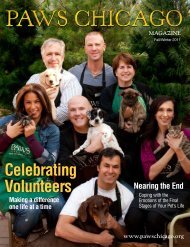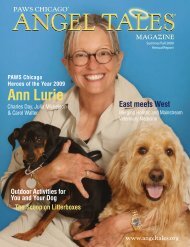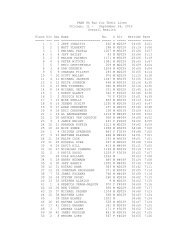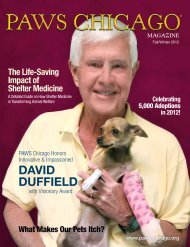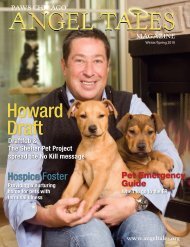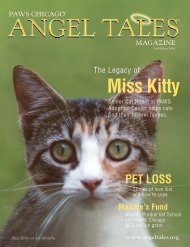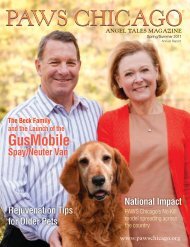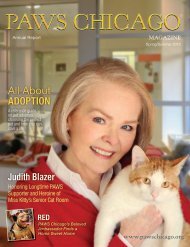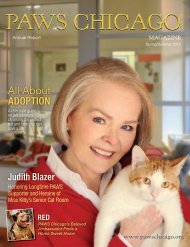Winter 2010 - PAWS Chicago
Winter 2010 - PAWS Chicago
Winter 2010 - PAWS Chicago
You also want an ePaper? Increase the reach of your titles
YUMPU automatically turns print PDFs into web optimized ePapers that Google loves.
For example, despite the existence of traditional<br />
shelters in <strong>Chicago</strong> for more than a century,<br />
the number of homeless pets killed in 1997 was a<br />
staggering 42,561. If traditional methods worked,<br />
pet overpopulation would not continue to plague<br />
our country’s homeless pets. In contrast, since<br />
<strong>PAWS</strong> <strong>Chicago</strong> took the No Kill message public<br />
with Angels with Tails in 1998, and with the help<br />
of all the wonderful <strong>Chicago</strong>ans who have rallied<br />
to help homeless pets, the killing has been reduced<br />
by more than half with 18,475 pets euthanized<br />
in 2009.<br />
The Advent of No Kill<br />
With the entire animal welfare system<br />
designed to kill the ever-increasing number of<br />
homeless dogs and cats, changing the direction<br />
of the tide was a huge undertaking. It would take<br />
vision, leadership, direction, and proof that lifesaving<br />
methods work to change the methodology<br />
of traditional sheltering.<br />
Through innovative programs, proactive<br />
adoptions, and many years of focused, targeted<br />
spay/ neuter, San Francisco created a progressive<br />
No Kill model that saves all animals; the only<br />
warranted euthanasia is for animals who are irremediably<br />
suffering, or those who are vicious<br />
and pose a threat to the public. But despite San<br />
Francisco’s proven track record of saving–not<br />
killing–homeless animals, many shelters and<br />
communities have not yet embraced the No Kill<br />
model. Many shelters and communities continue<br />
to kill homeless cats and dogs, rather than work to<br />
change the ineffective status quo. But the No Kill<br />
tide has already begun to swell.<br />
The No Kill Model<br />
Today, <strong>PAWS</strong> <strong>Chicago</strong> is leading the way as<br />
a national model in No Kill sheltering, but there<br />
are important distinct roles for government and<br />
private shelters in building No Kill communities.<br />
How a Model No Kill Community Works.<br />
In a model No Kill city, all healthy and treatable<br />
animals are saved. Euthanasia is reserved only for<br />
dogs or cats who are hopelessly sick or injured, or<br />
dogs who are vicious and therefore pose a real and<br />
immediate threat to public safety.<br />
Spay/Neuter clinics and spay/neuter vans<br />
make the service readily available and affordable,<br />
or free, for pets of low-income families. Spay/<br />
Neuter is essential to managing the population<br />
of unwanted pets, greatly reducing the volume of<br />
animals entering shelters and ultimately enabling<br />
all homeless animals to find homes.<br />
Private Shelters in a No Kill Community.<br />
In a model No Kill community, all private<br />
shelters manage their admissions much like<br />
human services do, taking in only as many pets<br />
as they can care for with all of their donor dollars<br />
going to saving, not ending, lives. This managed<br />
admissions approach works with each case individually<br />
so that his or her needs are met.<br />
The reality is that every institution has a<br />
capacity limit. If a hospital or domestic violence<br />
shelter has only 1,000 beds, they will not take in<br />
2,000 people and kill the excess. Much like their<br />
human counterparts, a No Kill shelter triages pets<br />
to take in crisis care and the neediest cases first.<br />
When a family gives up their pet, the shelter educates<br />
them on the reality of pet homelessness and<br />
offers educational counseling and alternatives.<br />
During the busiest times, these private shelters<br />
will ask people with less critical needs to keep<br />
their pet a few weeks or utilize a network of foster<br />
homes to take in pets while the shelter is operating<br />
at capacity.<br />
Once pets are in the adoption program, the life<br />
of each animal is prioritized. Private donor dollars<br />
go to treating and saving the lives of all healthy<br />
and treatable animals that come through the shelter’s<br />
doors. Traditional, open door shelters would<br />
no longer exist, since they are an outdated model<br />
that merely replicates government services.<br />
Government’s Role in a No Kill Community.<br />
Animal Care & Control, or the city pound, in a<br />
model community would serve as the central<br />
location for stray and unwanted pets and for<br />
cases of animal cruelty, they would work in conjunction<br />
with the city’s law enforcement. As the<br />
community’s open door shelter funded by tax<br />
dollars, they would take in all animals and be the<br />
single destination to search for lost pets.<br />
Private shelters would support the city shelter<br />
by transferring pets into their adoption programs.<br />
With an active transfer culture, there is a safety net<br />
for the pets who enter the city shelter. When the<br />
city agency is the only open door shelter in a community,<br />
any killing would be exposed with greater<br />
transparency and freedom of information legally<br />
mandated for government.<br />
Reaching No Kill<br />
As No Kill has become the commonly accepted<br />
sheltering model, many traditional open door<br />
shelters mask their killing through misleading terminology<br />
and misrepresentation of their shelter<br />
data. But knowledge is power.<br />
With the knowledge of what pets are facing<br />
in a community’s sheltering system, the public is<br />
mobilized to action, responding to the need. This<br />
response is visible in the 7,000 people who volunteer<br />
for <strong>PAWS</strong> <strong>Chicago</strong> because they believe in the<br />
No Kill model.<br />
By supporting No Kill with your time and<br />
resources, you are arming the revolution. Within<br />
five years, the war will be won and animals will<br />
no longer be killed in <strong>Chicago</strong>. We will be the<br />
model No Kill community, and the revolution<br />
will spread.<br />
> The Revolution:<br />
All About No Kill<br />
Article Guide<br />
No Kill Revolution<br />
Pages 26-27<br />
> The evolution of<br />
animal sheltering and the<br />
life‐changing rise of the<br />
No Kill movement, which<br />
values the life of each<br />
individual animal.<br />
When is No Kill<br />
truly No Kill<br />
Pages 28-30<br />
> Understanding the true<br />
definition of “No Kill” is<br />
the difference between<br />
life and death for millions<br />
of cats and dogs at<br />
animal shelters around<br />
the world.<br />
Transparency in<br />
Shelter Law<br />
Pages 31-34<br />
> Why transparency –<br />
the accurate disclosure<br />
of animal shelter data<br />
including admissions,<br />
adoptions, euthanasia<br />
rates, and the number<br />
of animals who died in<br />
a shelter – matters and<br />
its impact on the lives<br />
of animals and donor<br />
decisions.<br />
27



